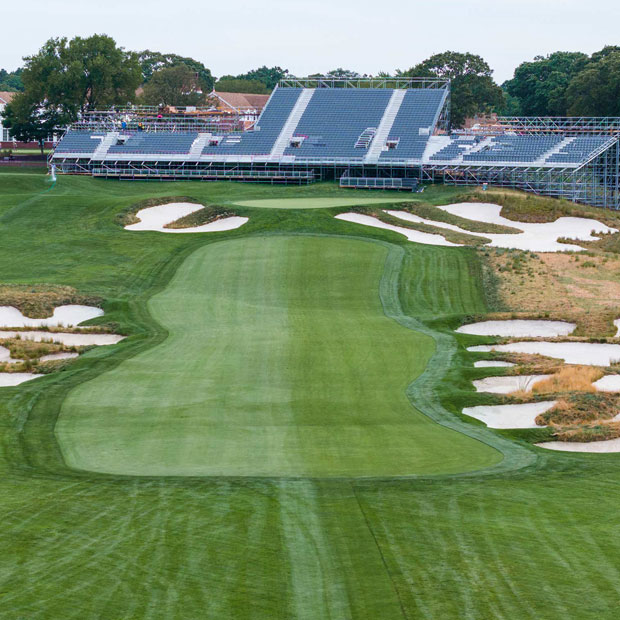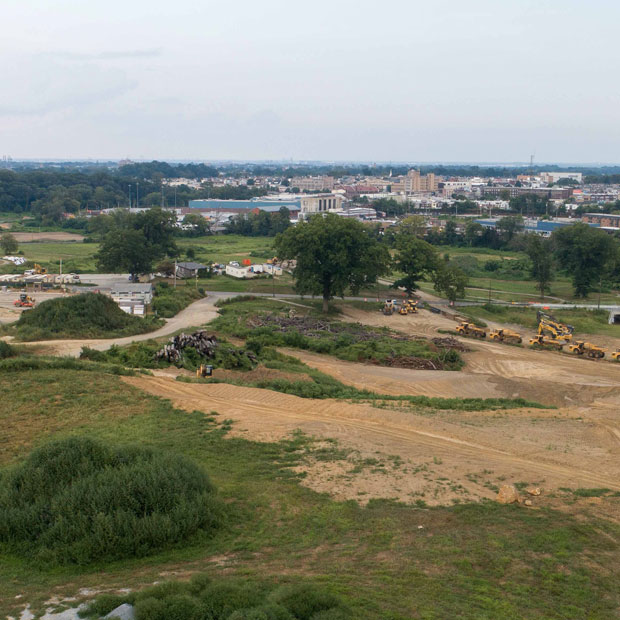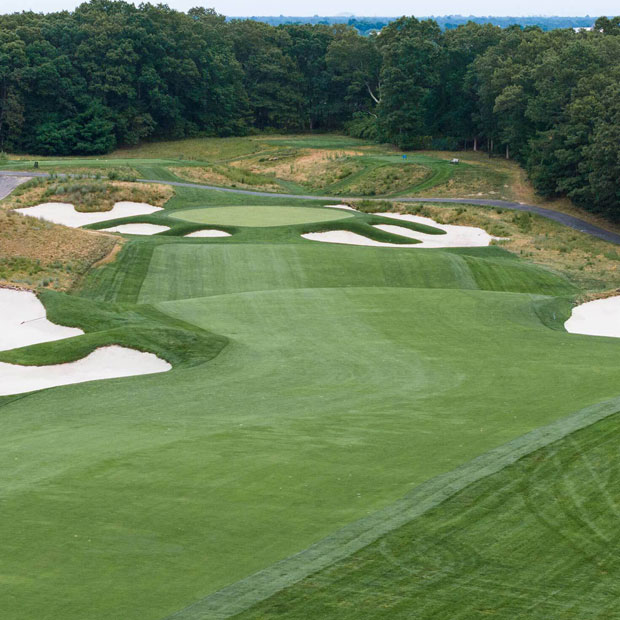Design Notebook: Details on the Upcoming Harbour Town Renovation
Plus: thoughts on Coore & Crenshaw’s Pinehurst No. 11 commission
.jpeg)
.jpeg)
Happy spring and welcome back to Design Notebook, where we cracked ourselves up this past Sunday thinking about how Alister MacKenzie would have gone about hiding Easter eggs. The kids wouldn’t have been able to find anything!
Yes, we’re dorks.
Anyway, this edition of DN offers an in-depth look at Love Golf Design’s plans for this year’s renovation of Harbour Town Golf Links. I also give some takes on yesterday’s news that Bill Coore and Ben Crenshaw will design Pinehurst No. 11. Let’s dig in.
What to Expect from Love Golf Design’s Harbour Town Project
With the 2025 RBC Heritage in the books, host venue Harbour Town Golf Links is getting ready for a makeover. On May 5, the course will shut down for a major renovation by Love Golf Design. The primary aim of the project will be to restore many aspects of the 1969 Pete Dye design. In the process of rebuilding every bunker and green, LGD will re-create the original shapes and sizes of several bunkers, reintroduce a few bunkers that have been lost over the years, expand some greens to their initial dimensions, and recapture certain nuances of Dye’s green contouring.
Since Harbour Town is an annual PGA Tour venue, however, the renovation won’t be purely an exercise in historical research and recovery. LGD will also add some length to the course (and indeed had already lengthened holes 2, 5, and 17 before this year’s tournament), upgrade the practice area, and install up-to-date agronomic infrastructure under the new bunkers and greens. The course is expected to reopen in mid-November this year.
To get some additional color on the project, I called up Love Golf Design’s lead architect Scot Sherman, who worked for the Dye family in the 1990s. Here is a transcript of our chat, condensed and lightly edited for clarity:
Garrett Morrison: What’s a particular aspect of Harbour Town’s original design that you’re excited to bring back?
Scot Sherman: We’re working on some details that really speak to what Pete did originally that didn’t last real long. He did some sod-stacking to several bunkers out there, and from the pictures and from recollections of others, some of that stacking was with Bahia and or St. Augustine grass, and it didn’t last long. And natural sod-stacking usually has to be replaced every three or four or five years, and [Harbour Town] just didn’t do it and [eventually] just grassed the faces. So again, in a tip of the cap to [Dye], we’re going to go ahead and do some of these that were originally stacked, but we’re going to do it in a little bit of a modern context. We think we could do something that’ll last a little longer. We have an artificial product, and we’re going to alternate artificial stacking with natural sod. We really don’t want it to look artificial, but we also want there to be hints of the sod-stacking. So we’re going to do a row of the artificial, a row of Celebration [Bermudagrass] sod, a row of the artificial, a row of the Celebration, and it’ll fuzz a little bit, and you’ll be able to discern the stacking.
Garrett: So the outcome of this sod-stacking process — will it look like a revetted bunker, like you would see in Scotland?
Scot: It’ll have a little bit different appearance. It won’t be that clean revetment like you’re used to seeing, and nor was Pete’s original sod-stacking. It’s going to be a little fuzzier, a little more ragged.
Between ourselves and the owner and the old pictures that we have from the late 60s — the original tournament there that Mr. Palmer won — we’re going to put some of them back. I don’t know that we’re putting all of the ones we know about back, but some of that’s going to be a field decision. For example, there were a couple [sod-stacked bunkers] behind No. 9 green. Those are going to go back for sure. We’re putting back the dreaded deep pot bunker left of 14 green.
Garrett: Which hole are you most looking forward to working on? Is it the [par-3] 14th?
Scot: Fourteen I’m most excited about just because that little short hole is one of the smallest golf holes in the world, and it was mean. And it is mean, and it’s just going to be meaner with that bunker back. The low is still there. It’s just grass now, and it’s not nearly as deep.

Garrett: There’s still a bunker back left on 14, right?
Scot: Yeah, it’s sort of more behind the green now. Pete put that in himself once the [initial] pot bunker midway up the green went away. We’re going to keep it, since he had something to do with it. But we’re going to put the original pot back. We’ve got lots of pictures and actually a video of a golfer in it. There’s a very famous, or at least easily accessible, video of Rik Massengale in that bunker, with Vin Scully commentating while [Massengale] hit several shots trying to get out of that thing. That’s a video we refer to a lot. The tree that’s right next to that bunker is still there, so it’s given us reference as to where to put it.
Garrett: When you look at early images of the course like that one with Massengale, it obviously had a very different appearance than it does now. It was initially quite rustic and even swampy. You could feel the Lowcountry. A lot of that has gone away over the years as maintenance has gotten more refined. How do you approach trying to restore a course to its original form when you can’t go all the way back to that early rugged aesthetic because you still have to host a PGA Tour event every year?
Scot: Well, it’s a balancing act. I mean, Pete is the first one that would’ve ever gone to any of his golf courses on opening day and had a list of 30 things he wanted to change and improve and update. I mean, he’s the first one. So in the modern context, he would do the same thing.
Obviously, length is something to study, and we’ve done some of that. Modern construction techniques are something to study. But the bones of the golf course — meaning the routing, the balance, the left-to-right and right-to-left tee shots, and the green settings — all of those things will not change. The depth and the meaning and the strategy of the bunkers and the trees — those certainly won’t change.
We have hesitated to move bunkers, but we haven’t hesitated to move tees back. And of course we can only do so much of that. But I noticed yesterday [in the final round of the 2025 RBC Heritage] the golf course was set up at just a hair under 7,100 yards and didn’t play easy. That golf course defends itself well. Always has, probably always will.
Garrett: What about Harbour Town’s architecture stands out to you the most?
Scot: I don’t know if I’m saying this the right way, but it’s my impression of Pete and [his wife] Alice’s best work — and I’m careful to say Pete and Alice because they did things together for sure — their best work seems to be the most eclectic. And what I mean by that is there’s often different styles going on. Some big bunkers, some little bunkers. He used to say, “Let’s build this just like that, only different.” They’re related, but they’re not twins.
If you look at Harbour Town, you’ve got planking, you’ve got telephone poles, you’ve got railroad ties, you’ve got shell material [in the waste areas], you’ve got pine straw, you’ve got pines and oaks, and every golf hole is different. It’s hard to confuse those golf holes because something about them is very distinctive. No. 13 is nothing like No. 1. And that’s a very good example of being eclectic. You’re dropped from an airplane from Planet Mars, and you look at No. 1, and then you look at No. 13, the thing that binds them all together is the vegetation of the site, but those two golf holes are so different from each other, which I think is the course’s strength.
{{design-notebook-harbour-town-content-block-01}}
Garrett: You’ve mentioned to me before that you have some personal history with Harbour Town. Could you tell me about that?
Scot: Well, I was first introduced to it as a kid on television. I saw it for a number of years, watching the tournament with my dad on television. But my first time on the ground was during the 1989 Nabisco Championship, the forerunner of the Tour Championship. It was in the fall, and Tom Kite won. That was the first time I had a chance to walk the golf course, and I was trying to figure out what to do as far as a career was concerned. I was interested in golf and had finished college and was trying to figure out, How do I do this? How do I get into the golf design business? And I walked that golf course, and I’m sure somewhere after the 14th hole, I was like, well, I wonder if Pete Dye’s hiring anybody. And I eventually corresponded with [Dye’s wife] Ms. Alice when they were building the Ocean Course [at Kiawah Island]. And that was the first time I actually met them, while they were building the Ocean Course. And lo and behold, their son [P.B.] hired me for some projects that he and Pete were doing.
So Harbour Town is a very special place. I just never dreamed I’d be working there. So it’s got a special place in my heart. And this is the honest-to-God truth — you can ask my children, you can ask friends and foes alike around me — my ashes will be sprinkled behind the 17th green around that palm tree whenever it is I go, tomorrow or in 30 years, whenever I go. That’s where my ashes are going.
Pinehurst Goes for the Doak-Coore Double
Pinehurst Resort announced that Coore & Crenshaw will build Pinehurst No. 11, the second course at Pinehurst Sandmines in Aberdeen, North Carolina. The satellite facility’s first course, Tom Doak’s Pinehurst No. 10, debuted last year.
I’m intrigued by Coore’s description of the new property. He suggests that the site has fewer dramatic elevation changes than No. 10 but that the land is choppier, quirkier, and more densely packed with remnants of an early-20th-century sand-mining operation. (Only one hole on Doak’s course, the eighth, prominently features mining spoils.) As a big fan of golf on small-scale terrain with eccentric vertical landforms, I can’t wait to see what Coore does with No. 11.
{{design-notebook-harbour-town-content-block-02}}
It’s also notable that Coore will apparently have more time to complete his work than Doak did. Pinehurst No. 10 was announced in January 2023 and finished later that year, in time for a spring 2024 debut. On No. 11, Coore will have a two-year runway, breaking ground sometime in 2025 and opening, if all goes to plan, in fall 2027. There could be many reasons for the longer timeline: the site could be more complex; drainage and irrigation contractors could be harder to schedule at the moment; or the resort could simply be in less of a hurry, given that No. 10 and the Sandmines facility are already up and running. Nonetheless, I’m reminded of the one-word answer Coore’s partner Ben Crenshaw gave when a young Geoff Shackelford asked him for the secret to great golf architecture: “time.” Coore & Crenshaw will have more of it than Doak did.
I would imagine there will be some of the usual grumbling about the uninventiveness of hiring Doak and Coore & Crenshaw back to back. My response to these hypothetical complaints: *shrug emoji*. Tom Doak and Bill Coore are the two defining golf architects of the early 21st century. No one else is particularly close, even if it’s customary to speak of a Big Three (Doak, Coore, and Gil Hanse) or a Big Four (the Big Three plus David McLay Kidd). If you can hire Doak and Coore, that’s what you do. It would be unreasonable to expect Pinehurst to make another choice.
Partly because of their shared knack for getting desirable jobs, Tom Doak and Coore & Crenshaw have frequently worked for the same clients on neighboring sites. Think of Bandon Dunes (Doak: Pacific Dunes and Old Macdonald; C&C: Bandon Trails and Sheep Ranch), Sand Valley (Doak: Sedge Valley and The Lido; C&C: Sand Valley and The Sandbox), Streamsong (Doak: the Blue Course; C&C: the Red Course), and Te Arai (Doak: the South Course; C&C: the North Course).
All of these side-by-side projects beg the question: how are Doak’s and Coore & Crenshaw’s design styles both similar to and distinct from each other?
I’ll follow up with my own thoughts on this topic in a future article, but I’d like to hear from Club TFE members first. Hit the comment section below!
Chocolate Drops
→ Royal Dornoch Golf Club informed members in an email yesterday that King Collins Dormer will create a master plan for the club’s Struie Course. This is surprising news. In recent years, British firm Mackenzie & Ebert has worked with Royal Dornoch on changes to its famed Championship Course. I had assumed that M&E would also oversee a renovation of the Struie, for which the club purchased 50 additional acres last year. King Collins Dormer must have come through with a compelling proposal.
Royal Dornoch’s email to members mentions that nine different golf architecture firms competed for the job. “Our thanks go to all the firms who visited the site and presented us with a proposal, as each one was of a very high quality and would have been a good solution for Royal Dornoch,” the club said. “However, it was felt that KCD’s ideas fulfilled the brief in an innovative way that will provide the range of facilities we desire, make best use of the land available and the land we have just purchased.”
→ After a soup-to-nuts redesign by Jay Blasi, Poppy Ridge Golf Course in Livermore, California, will reopen on May 31, 2025. This should be an excellent new public golf option.

→ Brian Schneider announced this past Sunday that his plan for a “major renovation” of San Diego Country Club has been approved by the membership. Work will begin in fall 2026.
→ If you haven’t already, check out my colleague Matt Rouches’s write-up on Augusta National’s plans for a renovation of The Patch, Augusta’s beloved municipal course.
A Course We Photographed Recently
The Stadium Course at PGA West (La Quinta, CA)—designed by Pete Dye in 1986, renovated by Bobby Weed in 2024
{{design-notebook-harbour-town-content-block-03}}
Quotable
“Formal contests are generally much worse [than more haphazard methods of hiring a golf architect]. Clubs interview several architects and make them jump through all kinds of ridiculous hoops, even though they have already narrowed it down to one or two candidates… they just want to look like they’re being fair. The last job I lost, the client told me afterward that it was always going to be between me and Bill Coore [whom they hired], and that he was mortified how other firms had put so much work into their presentations when they never had a chance of getting the job.” – Tom Doak
Leave a comment or start a discussion
Engage in our content with thousands of other Fried Egg Golf Members
Engage in our content with thousands of other Fried Egg Golf Members
Get full access to exclusive benefits from Fried Egg Golf
- Member-only content
- Community discussions forums
- Member-only experiences and early access to events















Leave a comment or start a discussion
Lorem ipsum dolor sit amet, consectetur adipiscing elit. Suspendisse varius enim in eros elementum tristique. Duis cursus, mi quis viverra ornare, eros dolor interdum nulla, ut commodo diam libero vitae erat. Aenean faucibus nibh et justo cursus id rutrum lorem imperdiet. Nunc ut sem vitae risus tristique posuere. uis cursus, mi quis viverra ornare, eros dolor interdum nulla, ut commodo diam libero vitae erat. Aenean faucibus nibh et justo cursus id rutrum lorem imperdiet. Nunc ut sem vitae risus tristique posuere.